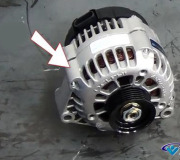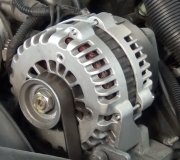A bigger generator is never the answer, and it can result in more problems. There's going to be a fuse link wire in series with the wire going from the output terminal back to the battery, and the size of that wire is selected based on the current capacity of the generator the car came with. Installing one with a higher output will not cause a problem until the charging system is load-tested. No generator will put out more current than what the electrical system calls for, so all that's important is it is big enough to meet the highest demands under various conditions. It's only during that load-test that the unit will try to deliver it's maximum current, and that's when that fuse link is going to burn open.
In this case, what you described is typical of one bad diode of the six inside the generator. The load-test will show this as a very high "ripple" voltage, and the most output current will be exactly one third of the generator's rated current. 30 amps from the common 90 amp generator is not enough to run the entire electrical system under all conditions. The battery will have to make up the difference until it slowly runs down over days or weeks. The clue is the slowly flashing signal lights.
Ford also used to commonly add two more diodes to collect some wasted energy and bump up a generator's output capacity a little. Those don't commonly fail, but if one does, that will reduce the output too, but not by two thirds. In fact, that may not show up on a load-test unless you know for certain what the current rating is and what it should be able to deliver.
You can start the diagnosis yourself with a digital voltmeter. Battery voltage must be 12.6 volts with the engine off if it is fully-charged. It must be fully-charged for testing of the charging system to be accurate. Next, with the engine running, battery voltage must be between 13.75 and 14.75 volts. It must stay there as you turn on more and more loads like the heater fan and rear window defogger, but to be accurate, you need a professional load tester. Also, all generators are very inefficient at low speeds. Part of the professional test involves raising engine speed to 2,000 rpm.
It is not practical to replace the diode blocks, and it will usually cost more to try to do so than the cost of a rebuilt generator. Before you assume the generator is causing the low output, don't overlook a loose or slipping belt. If your engine uses a spring-loaded tensioner pulley, tug on the belt and watch that the arm moves freely when it releases and when it takes up the slack again. If it is tight or it sticks, replace that first.
Tuesday, January 14th, 2014 AT 11:02 PM




